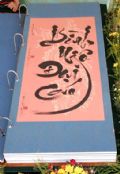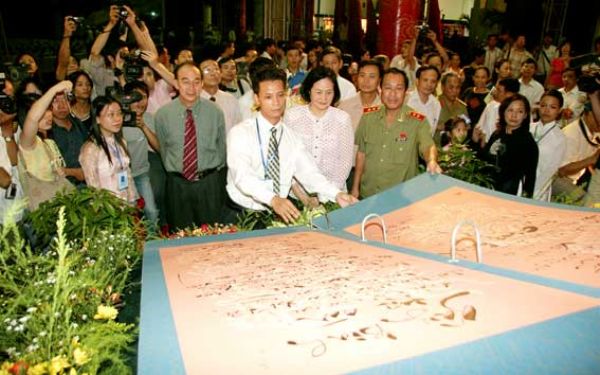|
|

Taking the calligraphy
book to the exhibition.

A page in the work.

Trinh Tuan presents calligraphic andwritingsnbsp;
to viewers.
|
The largest Vietnamese calligraphy book outlining the three Declarations of Independence impresses any viewer because of the high quality calligraphy and its historical value. It is the second record by Trinh Tuan, the other being the 300m-long calligraphy masterpiece entitled “The Story of Kieu” in 2005.
Viewing the three works in the wooden book, “Rivers and Mountains of the South Nation” by Ly Thuong Kiet in the 10th century, “Proclamation of the Victory over Foreign Aggressors” by Nguyen Trai in the 15th century and “The Declaration of Independence” by President Ho Chi Minh in the 20th century, readers can perceive the sublimation of the author via his refined and elegant lines. These immortal works affirm the Vietnamese people’s undaunted spirit to fight against invaders and the forceful proclamation on territorial sovereignty. Surprisingly, they were born by accident in terms of time – each appeared about 500 years apart, marking three glorious historical landmarks of Vietnamese people.
After 21 days and night of labouring unrelentingly, Trinh Tuan completed the book, made of rare kinds of wood and paper, measuring 0.9 x 2.1m and weighing 300kg. It includes 43 pages, each being 5cm thick and made from Xuyen chi paper which is very durable. The book’ name was carved delicately and the three Declarations of Independence were designed on a backdrop displayingnbsp; typical designs of each historical period, such as the dragon in the Ly and Le Dynasties and stylized lotuses. The author used brushes, Chinese ink and paper and deciphered the works in Vietnamese calligraphy. “I want to send a message of history which is not only dedicated to the contributions of those who died for the country’s independence but also stimulates the youth of today. The works I select to write down have political, scholarly and community cultural values,” Tuan said.
|

Trinh Tuan opens the first page of the calligraphy book at Van Ho
Exhibition Centre.
nbsp;
nbsp;
|
“It is the first time I saw the work in Vietnamese calligraphy which is very unique and I admire the young calligrapher very much,” said Faruhmammer, a German viewer.
Historian Duong Trung Quoc said: “A unique idea together with painstakingly working and a bright and sincere heart for the predecessors and heritage create the work of Trinh Tuan”.
Story bynbsp;Vuong Mo - Photos by Le Minh
|